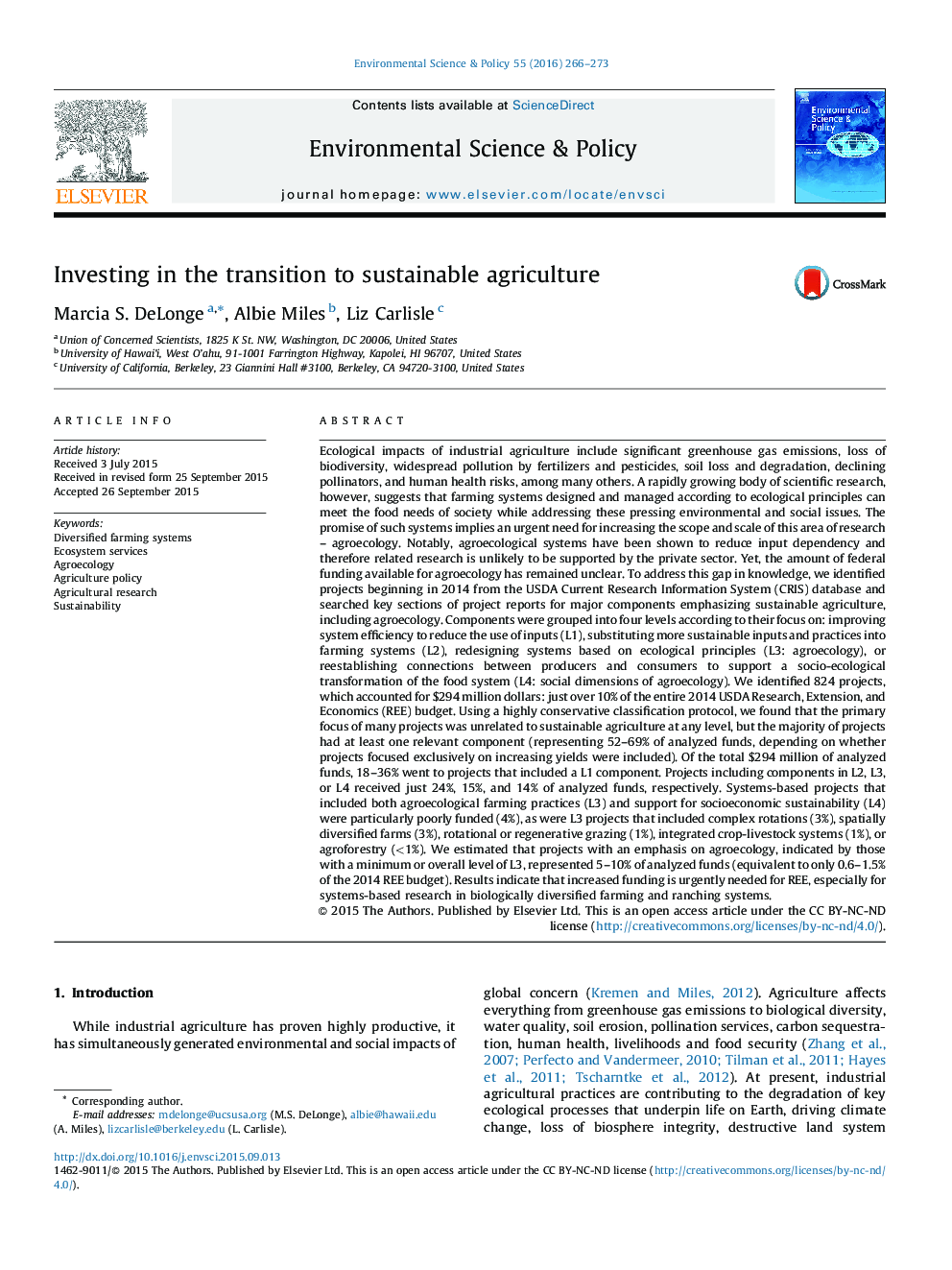| کد مقاله | کد نشریه | سال انتشار | مقاله انگلیسی | نسخه تمام متن |
|---|---|---|---|---|
| 10504573 | 946686 | 2016 | 8 صفحه PDF | دانلود رایگان |
عنوان انگلیسی مقاله ISI
Investing in the transition to sustainable agriculture
ترجمه فارسی عنوان
سرمایه گذاری در انتقال به کشاورزی پایدار
دانلود مقاله + سفارش ترجمه
دانلود مقاله ISI انگلیسی
رایگان برای ایرانیان
کلمات کلیدی
سیستم های کشاورزی متنوع خدمات محیط زیستی، کشاورزی سیاست کشاورزی، تحقیقات کشاورزی، پایداری،
موضوعات مرتبط
مهندسی و علوم پایه
مهندسی انرژی
انرژی های تجدید پذیر، توسعه پایدار و محیط زیست
چکیده انگلیسی
Ecological impacts of industrial agriculture include significant greenhouse gas emissions, loss of biodiversity, widespread pollution by fertilizers and pesticides, soil loss and degradation, declining pollinators, and human health risks, among many others. A rapidly growing body of scientific research, however, suggests that farming systems designed and managed according to ecological principles can meet the food needs of society while addressing these pressing environmental and social issues. The promise of such systems implies an urgent need for increasing the scope and scale of this area of research - agroecology. Notably, agroecological systems have been shown to reduce input dependency and therefore related research is unlikely to be supported by the private sector. Yet, the amount of federal funding available for agroecology has remained unclear. To address this gap in knowledge, we identified projects beginning in 2014 from the USDA Current Research Information System (CRIS) database and searched key sections of project reports for major components emphasizing sustainable agriculture, including agroecology. Components were grouped into four levels according to their focus on: improving system efficiency to reduce the use of inputs (L1), substituting more sustainable inputs and practices into farming systems (L2), redesigning systems based on ecological principles (L3: agroecology), or reestablishing connections between producers and consumers to support a socio-ecological transformation of the food system (L4: social dimensions of agroecology). We identified 824 projects, which accounted for $294 million dollars: just over 10% of the entire 2014 USDA Research, Extension, and Economics (REE) budget. Using a highly conservative classification protocol, we found that the primary focus of many projects was unrelated to sustainable agriculture at any level, but the majority of projects had at least one relevant component (representing 52-69% of analyzed funds, depending on whether projects focused exclusively on increasing yields were included). Of the total $294 million of analyzed funds, 18-36% went to projects that included a L1 component. Projects including components in L2, L3, or L4 received just 24%, 15%, and 14% of analyzed funds, respectively. Systems-based projects that included both agroecological farming practices (L3) and support for socioeconomic sustainability (L4) were particularly poorly funded (4%), as were L3 projects that included complex rotations (3%), spatially diversified farms (3%), rotational or regenerative grazing (1%), integrated crop-livestock systems (1%), or agroforestry (<1%). We estimated that projects with an emphasis on agroecology, indicated by those with a minimum or overall level of L3, represented 5-10% of analyzed funds (equivalent to only 0.6-1.5% of the 2014 REE budget). Results indicate that increased funding is urgently needed for REE, especially for systems-based research in biologically diversified farming and ranching systems.
ناشر
Database: Elsevier - ScienceDirect (ساینس دایرکت)
Journal: Environmental Science & Policy - Volume 55, Part 1, January 2016, Pages 266-273
Journal: Environmental Science & Policy - Volume 55, Part 1, January 2016, Pages 266-273
نویسندگان
Marcia S. DeLonge, Albie Miles, Liz Carlisle,
